#from our german correspondents
Explore tagged Tumblr posts
Text
Legendary German Gentleman Thief "Grand Theft" Otto Allegedly Leaves Plane With Extra Pack Of Peanits
Investigators were shocked when they found evidence that longtime Berlin resident Otto Allegedly (aged 45) was the infamous "Grand Theft" Otto - he was caught red-handed at 8 pm last Thursday leaving the airport with something extra squirreled away in his pants; an incriminating sack of nuts. Otto had this to say: "I thought these came free with my flight. This is all crazy, I'm not 'Grand Theft' Otto... we simply have the same first name." Detectives are not so convinced, though, as there are many similarities between the two. Police Chief Fickendich weighs in - "According to our intelligence there are many undeniable similarities between eyewitness accounts of the criminal and our suspect. Both were in Germany. Both are a man or woman between the ages of 18 and 60. Both, of course, have the same name." Otto is scheduled to be executed at dawn.
Coming up next, breaking news: the Prinzessinhoden diamond, evaluated at over 3 billion doubloons, has been reported stolen this morning. "Must have been the wind," experts claim.
1 note
·
View note
Text
I'm spinning this off of the main thread about tracing the origin of the term "d66" because it's not strictly germane to the topic – none of these examples actually use the term "d66" to describe their dice-rolling methods – but I'm going to post it anyway as a matter of general interest: following a conversation with Tumblr user @notclevr, it appears that before tabletop wargames (and, nearly concurrently, tabletop RPGs) got their hands on the mechanic, the principal (though by no means exclusive) users of the old "roll a six-sided die twice, reading one die as the 'tens' place and the other die as the 'ones' place" trick may have been tabletop American baseball simulators.
The most notable example of the type – and the only well-known example still in publication today – is J Richard Seitz' APBA Baseball, first published in either 1950 or 1951 (accounts vary). In this game, a d66 roll is cross-referenced with a card representing the active player and a "board" representing the current situation on the field:



For example, with Carlton Fisk at bat, a d66 roll of 31 would yield a result of "8". Assuming for the sake of argument that the situation on the field is a runner on first and a grade C pitcher, consulting the "Runner on First Base" board, this corresponds to an outcome of "SINGLE—line drive to left; runner to third".
(This example is, strictly speaking, incorrect, as Carlton Fisk didn't have his major league debut until 1969 and I'm using the wrong lookup tables for any year in which he played, but you get the idea!)
Interestingly, APBA Baseball is not the first game to use this setup. It's heavily derived from Clifford Van Beek's National Pastime, a game whose patent was registered in 1925, though it wasn't actually published until 1930. Even at a glance, the similarities are substantial:
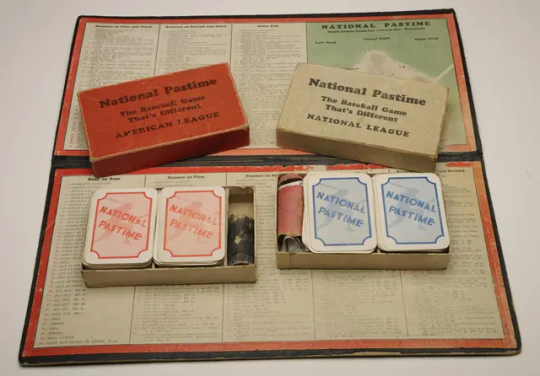


Indeed, though National Pastime's lookup tables are much simpler than APBA Baseball's, where they overlap they're often word for word identical. It's generally accepted that Seitz plagiarised National Pastime without credit when creating APBA Baseball (ironically, given his own famously combative stance toward alleged imitators!), though he was within his rights to do so, as National Pastime had fallen into the public domain by the time APBA Baseball was published.
We can go back even further, though. As far as I've been able to determine, the earliest known tabletop baseball simulator to use d66 lookup tables for resolving plays is Edward K McGill's Our National Ball Game, first published in 1886:


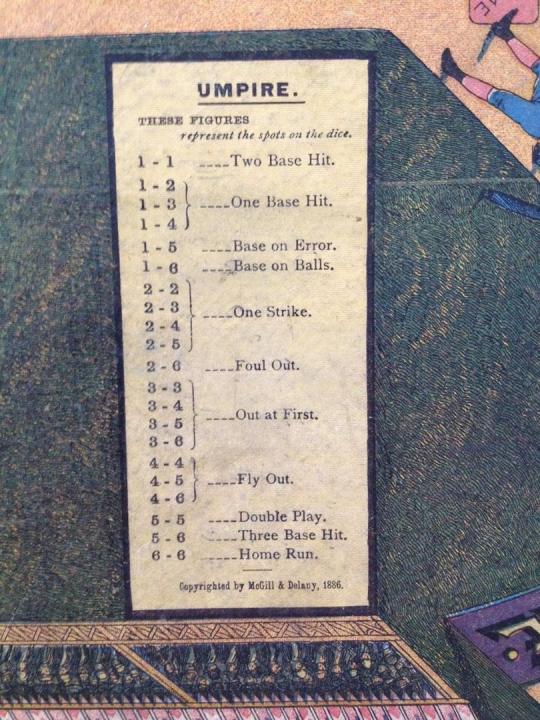
A copy of the game's 1887 US patent application can be downloaded here. This one uses an unusual 21-entry variant of the standard d66 lookup table in which the order of the rolled digits is insignificant, with doubles being half as likely as non-doubles rolls; it's unclear whether McGill was aware of this when he laid out the table. Unlike later incarnations of the genre, there are no individual player statistics, with all at-bats being resolved via the same table.
#gaming#tabletop games#board games#baseball#apba baseball#national pastime#our national ball game#game design#history
2K notes
·
View notes
Text
So here's one of the coolest things that has happened to me as a Tolkien nut and an amateur medievalist. It's also impacted my view of the way Tolkien writes women. Here's Carl Stephenson in MEDIEVAL FEUDALISM, explaining the roots of the ceremony of knighthood: "In the second century after Christ the Roman historian Tacitus wrote an essay which he called Germania, and which has remained justly famous. He declares that the Germans, though divided into numerous tribes, constitute a single people characterised by common traits and a common mode of life. The typical German is a warrior. [...] Except when armed, they perform no business, either private or public. But it is not their custom that any one should assume arms without the formal approval of the tribe. Before the assembly the youth receives a shield and spear from his father, some other relative, or one of the chief men, and this gift corresponds to the toga virilis among the Romans--making him a citizen rather than a member of a household" (pp 2-3). Got it?
Remember how Tolkien was a medievalist who based his Rohirrim on Anglo-Saxon England, which came from those Germanic tribes Tacitus was talking about? Stephenson argues that the customs described by Tacitus continued into the early middle ages eventually giving rise to the medieval feudal system. One of these customs was the gift of arms, which transformed into the ceremony of knighthood: "Tacitus, it will be remembered, describes the ancient German custom by which a youth was presented with a shield and a spear to mark his attainment of man's estate. What seems to the be same ceremony reappears under the Carolingians. In 791, we are told, Charlemagne caused Prince Louis to be girded with a sword in celebration of his adolescence; and forty-seven years later Louis in turn decorated his fifteen-year-old son Charles "with the arms of manhood, i.e., a sword." Here, obviously, we may see the origin of the later adoubement, which long remained a formal investiture with arms, or with some one of them as a symbol. Thus the Bayeux Tapestry represents the knighting of Earl Harold by William of Normandy under the legend: Hic Willelmus dedit Haroldo arma (Here William gave arms to Harold). [...] Scores of other examples are to be found in the French chronicles and chansons de geste, which, despite much variation of detail, agree on the essentials. And whatever the derivation of the words, the English expression "dubbing to knighthood" must have been closely related to the French adoubement" (pp 47-48.)
In its simplest form, according to Stephenson, the ceremony of knighthood included "at most the presentation of a sword, a few words of admonition, and the accolade." OK. So what does this have to do with Tolkien and his women? AHAHAHAHA I AM SO GLAD YOU ASKED. First of all, let's agree that Tolkien, a medievalist, undoubtedly was aware of all the above. Second, turn with me in your copy of The Lord of the Rings to chapter 6 of The Two Towers, "The King of the Golden Hall", when Theoden and his councillors agree that Eowyn should lead the people while the men are away at war. (This, of course, was something that medieval noblewomen regularly did: one small example is an 1178 letter from a Hospitaller knight serving in the Latin kingdom of Jerusalem which records that before marching out to the battle of Montgisard, "We put the defence of the Tower of David and the whole city in the hands of our women".) But in The Lord of the Rings, there's a little ceremony.
"'Let her be as lord to the Eorlingas, while we are gone.' 'It shall be so,' said Theoden. 'Let the heralds announce to the folk that the Lady Eowyn will lead them!' Then the king sat upon a seat before his doors and Eowyn knelt before him and received from him a sword and a fair corselet."
I YELLED when I realised what I was reading right there. You see, the king doesn't just have the heralds announce that Eowyn is in charge. He gives her weapons.
Theoden makes Eowyn a knight of the Riddermark.
Not only that, but I think this is a huge deal for several reasons. That is, Tolkien knew what he was doing here.
From my reading in medieval history, I'm aware of women choosing to fight and bear arms, as well as becoming military leaders while the men are away at some war or as prisoners. What I haven't seen is women actually receiving knighthood. Anyone could fight as a knight if they could afford the (very pricy) horse and armour, and anyone could lead a nation as long as they were accepted by the leaders. But you just don't see women getting knighted like this.
Tolkien therefore chose to write a medieval-coded society, Rohan, where women arguably had greater equality with men than they did in actual medieval societies.
I think that should tell us something about who Tolkien was as a person and how he viewed women - perhaps he didn't write them with equal parity to men (there are undeniably more prominent male characters in The Lord of the Rings and The Hobbit, at least, than female) but compared to the medieval societies that were his life's work, and arguably even compared to the society he lived in, he was remarkably egalitarian.
I think it should also tell us something about the craft of writing fantasy.
No, you don't have to include gut wrenching misogyny and violence against women in order to write "realistic" medieval-inspired fantasy.
Tolkien's fantasy worlds are DEEPLY informed by medieval history to an extent most laypeople will never fully appreciate. The attitudes, the language, the ABSOLUTELY FLAWLESS use of medieval military tactics...heck, even just the way that people travel long distances on foot...all of it is brilliantly medieval.
The fact that Theoden bestows arms on Eowyn is just one tiny detail that is deeply rooted in medieval history. Even though he's giving those arms to a woman in a fantasy land full of elves and hobbits and wizards, it's still a wonderfully historically accurate detail.
Of course, I've ranted before about how misogyny and sexism wasn't actually as bad in medieval times as a lot of people today think. But from the way SOME fantasy authors talk, you'd think that historical accuracy will disappear in a puff of smoke if every woman in the dragon-infested fantasy land isn't being traumatised on the regular.
Tolkien did better. Be like Tolkien.
#tolkien#middle earth#jrr tolkien#lord of the rings#lotr#the lord of the rings#eowyn#writing fantasy#fantasy#female characters#writing#historical fiction#medieval women#medieval history#medieval#history#womens history
9K notes
·
View notes
Text
The first impression the war seems to have made upon the Germans was that Red Army men fought with spectacular valor. They complained that the Soviet soldiers did not fight “sensibly” but kept on even when surrounded and outnumbered. “These fellows,” said a Nazi war correspondent on the second morning of the war, “fight with the consistency of madness until they cannot move a limb.” The Berlin correspondent of the New York Times noted: «Unlike that of any of the Germans’ former opponents, Russian morale appears to be totally oblivious to tank and Stuka attacks, and the Russians seem to continue to fight, particularly while the dreaded dive-bomber formations are assembling to break their resistance… This inability to throw panic into the Soviet ranks necessitated new and different tactics in Russia.» The Russians themselves did not make so high a claim as was conceded to them by their opponents. Marshal Timoshenko frankly told an interviewer that the first attacks of the terrible dive-bombers had considerably worried his troops. They soon got used to it, and even displayed amusement at some of the whistling and noise-producing devices with which the Germans tried to make “psychological attack.” The first stories of Red Army valor reached the world from Berlin rather than from Moscow. A German soldier, for instance, told of an attack on a forester’s cabin, which turned out to be a Russian machine-gun nest. Several times the Germans thought that the nest was completely demolished. They shot into the house with field guns until it was in flames. “But the [Russian] machine guns continued to spatter pitilessly…. We encircled them and threw in flame from flame throwers till the entire house was ablaze. Still the dare-devils would spring out of it, throw a bunch of hand grenades and then slip in again. Finally, our artillery crashed the charred, blackened ruins to pieces, not a single man escaped from that hell.” Many similar tales were told by Germans to indicate that in taking forts they had to blow them apart wall by wall and room by room and that even when they thought they had destroyed everything living, they found wounded Red Army soldiers still fighting on.
The Soviets Expected It, Anna Louise Strong, 1941
69 notes
·
View notes
Text

Yeah, I'm not taking this sitting down. Man, I really am not trying to have beef out here, but I refuse to have my good fucking name tarnished. To make a public post about me? Yeah, I'm going to share my side. The facts are as such:
I approached wolf on 12/20/23 about a NSFW commission inspired by one of their works. It would feature my sona and an aged up Donnie. As they mentioned, our initial conversation was good. We went back and forth during the sketch phase and I requested quite a lot of edits. I asked if I could pay them for these corrections.

it was right after this that wolf asked about Donnie's battle shell since it wasn't illustrated.


After this message, I did not hear back from wolf after 2/9/24 until I sent them a follow-up message 3/27/24

I did not hear back from wolf until today 5/6/24.
Now I cannot share the images of the art I received because it is NSFW, but I can tell you that the grey from my sona's body appeared to be missing. The ears of my sona were grey, but the body only looked yellow. Donnie was missing his purple arm marks, and his knee pads were still the same only now they were colored in black along with his mask. From here I will just send the conversation in its entirety.


For reference, this was the reference sheet they had.






I was then sent two pieces where the grey on my sona was very obvious and Donnie's markings were now present with the following text.

Now again, I wish I could show you the pieces, but I can't. I was offered a 50% refund for my troubles, but I was not interested in taking it because wolf had already done all the work.
I will say that I was extremely frustrated with the whole affair so the next part I will admit was a bit salty because while corrections had been made, I wasn't able to give any input so there were still mistakes in my sona's colors (specifically the underside of the tail was yellow instead of white and my grey arm had one side yellow) and Donnie's mask was still black. The following is our last correspondence on my blog.

This would have been the end of it for me. Except, I did not get the email. I waited in hopes it would come in, but none did. Since I was blocked I was forced to reach out from one of my side blogs @thisgoesouttoyoubaby which feel free to check. it's my reblog sideblog that I use to send my bestie memes. It dates back YEARS and is not used for spam.

As you can see I was blocked here.
Now I have been refreshing my email feed waiting. I know emails can take time, but I have no way to confirm if I'm getting my work because I was immediately blocked on thisgoesouttoyou with no response.
So I used another sideblog, this time @plowingon which you can again, freely search, its not a spam blog, but a blog I once made to record the live of my old german shepherd I had years ago when he was getting older.

And wouldn't you know it, I got my first email from wolf at

Coincidentally, only after I sent my last message to them.
Now I'm not interested in hurting wolf's reputation. I think you should still commission them if you'd like. I still am a fan of their art. I have no ill will, but fuck if I will stand by as someone tells me that I won't pay an artist. I never even said i wouldn't pay. I was just frustrated because they wouldn't follow their own three correction rule. They allowed me no recourse, and then they were petty before I could even confirm that I received the email.
Could I have been nicer?
Of course.
Could I have been more clear?
Absolutely.
But there is no world in which I tried to gaslight anyone. I pride myself on my honesty. I was not shy when paying them. I sent payment before we even began. I offered to pay them more and acknowledged I was a needy customer halfway through. So I apologize for this long post, but I wanted to make sure all of this was visible because how dare you call me a scammer, wolf.
You disappoint me.
91 notes
·
View notes
Text
“Ashkenazi Jews don’t actually have Levantine genetic ancestry” has been floating around lately among naïve and conspiracy minded anti-Zionists, a problematic claim that undermines actually correct anti-Zionist principles and defense of Palestinian rights. This claim is
absolutely irrelevant, as “blood” originating on the “soil” does not grant anyone any right to an ethnostate on any land. Using area-native ethnicity to justify discrimination and mass killing is bad when it’s Yamato Japanese discriminating against Korean, Mainland Chinese, and Taiwanese minorities in Japan and it’s bad when it’s Celtic-Germanic descent Brits oppressing Celtic-Germanic descent Irish who they’re genetically undifferentiatable from. It was bad when it was Hutus killing Tutsis and it was bad when it was the Khmer Rouge killing Chinese and Vietnamese Cambodians. The actions of the Israeli state in immiserating and slaughtering non-Jewish Palestinians would be equally harmful and wrong if the diaspora had never happened and every Israeli could trace their resident lineage in an unbroken line back to the time of the Second Temple, because it is bad to destroy people’s homes, burn their crops, imprison them, and kill them.
incorrect, at least according to current scientific consensus. Most genetic studies seem to indicate that Ashkenazim are of majority European descent and also have ancestry in the Levant, that is: the Ashkenazi population had some Levantine founders and there’s been significant amounts of intermarriage over the hundreds and hundreds of years of the diaspora into Southern Europe and from there across Central and Eastern Europe.
irrelevant again because even if, through a combination of conversions, adoptions, intermarriage, and adulterous and out of wedlock pairings between Jews and local gentiles, the diasporic European Jewish population had become completely genetically indistinguishable from local gentiles, those Jews would still have been the children of Israel. They still would have learned to read the Torah and celebrate its festivals. They still would have learned, from their families and communities in an unbroken line, to pray “Sh’ma Yisrael, Adonai eloheinu, Adonai echad” (Hear, Israel, the Lord is our God, the Lord is one) as the rabbinic sages of Roman Judea observed in the Talmud that they were commanded to do. They still would have spoken languages with Hebrew and Aramaic elements, and they still would have written them with letters recognizable in the Dead Sea Scrolls. They still would have had the same interests, affirmed daily and yearly, in the land that their people left so many hundreds of years ago.
One formulation of the claim is “Israel bans direct to consumer genetic testing because it shows that (Ashkenazi) Jews don’t have Middle Eastern ancestry”. The Israeli government does ban DTC genetic testing as part of a genetic information privacy and nondiscrimination law passed in 2000, before companies like 23andMe existed. DNA testing for ancestry can be interpreted and presented many ways, and the ancestry breakdowns given by DTC GT companies just do not correspond to the question “where, how, and through what migrations did this population originate?”.
Once again, Zionism is not bad because people residing in places their ancestors are not from is bad. That is fine. Zionism is bad because from its beginning the Zionist project has been one of violent dispossession and because that violent dispossession continues in and through this very present moment.
155 notes
·
View notes
Text
Please read the movie descriptions below
Saving Private Ryan (1998) - Following the Normandy Landings, a group of U.S. soldiers go behind enemy lines to retrieve a paratrooper whose brothers have been killed in action. Dir. by Steven Spielberg
A League of Their Own (1992) - American sports comedy drama film that tells a fictionalized account of the real-life All-American Girls Professional Baseball League (AAGPBL) during WWII. Dir. by Penny Marshall
Greyhound (2020) - The film is based on the 1955 novel The Good Shepherd, and follows a US Navy commander on his first assignment commanding a multi-national escort destroyer group of four, defending an Allied convoy from U-boats during the Battle of the Atlantic. Dir. by Aaron Schneider
Mudbound (2017) - The film depicts two World War II veterans – one white, one black – who return to rural Mississippi each to address racism and PTSD in his own way. Dir. by Dee Rees
Twelve O'Clock High (1949) - A tough-as-nails general (Gregory Peck as General Savage) takes over a B-17 bomber unit suffering from low morale and whips them into fighting shape. Based on a novel by the same name. Dir. by Henry King
The Best Years of Our Lives (1946) - three United States servicemen re-adjusting to societal changes and civilian life after coming home from World War II. The three men come from different services with different ranks that do not correspond with their civilian social class backgrounds. It is one of the earliest films to address issues encountered by returning veterans in the post World War II era. Dir. by William Wyler
The Monuments Men (2014) - An unlikely World War II platoon is tasked to rescue art masterpieces from German thieves and return them to their owners. Based on the 2007 non-fiction book The Monuments Men: Allied Heroes, Nazi Thieves and the Greatest Treasure Hunt in History. Dir. by George Clooney
Dunkirk (2017) - Allied soldiers from Belgium, the British Commonwealth and Empire, and France are surrounded by the German Army and evacuated from Dunkirk. It is shown from the perspectives of the land, sea, and air. Dir. by Christopher Nolan
Fury (2014) - A grizzled tank commander makes tough decisions as he and his crew fight their way across Germany in April, 1945. Dir. by David Ayer
Valkyrie (2008) - A dramatization of the July 20, 1944 assassination and political coup plot by desperate renegade German Army officers against Adolf Hitler during World War II. Dir. by Bryan Singer
52 notes
·
View notes
Text
Socialism: Utopian and Scientific - Part 10
[ First | Prev | Table of Contents | Next ]
To return to our British bourgeois. The French Revolution gave him a splendid opportunity, with the help of the Continental monarchies, to destroy French maritime commerce, to annex French colonies, and to crush the last French pretensions to maritime rivalry. That was one reason why he fought it. Another was that the ways of this revolution went very much against his grain. Not only its "execrable" terrorism, but the very attempt to carry bourgeois rule to extremes. What should the British bourgeois do without his aristocracy, that taught him manners, such as they were, and invented fashions for him – that furnished officers for the army, which kept order at home, and the navy, which conquered colonial possessions and new markets aboard? There was, indeed, a progressive minority of the bourgeoisie, that minority whose interests were not so well attended to under the compromise; this section, composed chiefly of the less wealthy middle-class, did sympathize with the Revolution, but it was powerless in Parliament.
Thus, if materialism became the creed of the French Revolution, the God-fearing English bourgeois held all the faster to his religion. Had not the reign of terror in Paris proved what was the upshot, if the religious instincts of the masses were lost? The more materialism spread from France to neighboring countries, and was reinforced by similar doctrinal currents, notably by German philosophy, the more, in fact, materialism and free thought generally became, on the Continent, the necessary qualifications of a cultivated man, the more stubbornly the English middle-class stuck to its manifold religious creeds. These creeds might differ from one another, but they were, all of them, distinctly religious, Christian creeds.
While the Revolution ensured the political triumph of the bourgeoisie in France, in England Watt, Arkwright, Cartwright, and others, initiated an industrial revolution, which completely shifted the centre of gravity of economic power. The wealth of the bourgeoisie increased considerably faster than that of the landed aristocracy. Within the bourgeoisie itself, the financial aristocracy, the bankers, etc., were more and more pushed into the background by the manufacturers. The compromise of 1689, even after the gradual changes it had undergone in favor of the bourgeoisie, no longer corresponded to the relative position of the parties to it. The character of these parties, too, had changed; the bourgeoisie of 1830 was very different from that of the preceding century. The political power still left to the aristocracy, and used by them to resist the pretensions of the new industrial bourgeoisie, became incompatible with the new economic interests. A fresh struggle with the aristocracy was necessary; it could end only in a victory of the new economic power. First, the Reform Act was pushed through, in spite of all resistance, under the impulse of the French Revolution of 1830. It gave to the bourgeoisie a recognized and powerful place in Parliament. Then the Repeal of the Corn Laws [a move toward free- trade], which settled, once and for all, the supremacy of the bourgeoisie, and especially of its most active portion, the manufacturers, over the landed aristocracy. This was the greatest victory of the bourgeoisie; it was, however, also the last it gained in its own exclusive interest. Whatever triumphs it obtained later on, it had to share with a new social power – first its ally, but soon its rival.
The industrial revolution had created a class of large manufacturing capitalists, but also a class – and a far more numerous one – of manufacturing work-people. This class gradually increased in numbers, in proportion as the industrial revolution seized upon one branch of manufacture after another, and in the same proportion it increased its power. This power it proved as early as 1824, by forcing a reluctant Parliament to repeal the acts forbidding combinations of workmen. During the Reform agitation, the workingmen constituted the Radical wing of the Reform party; the Act of 1832 having excluded them from the suffrage, the formulated their demands in the People's Charter, and constituted themselves, in opposition to the great bourgeois Anti-Corn Law party, into an independent party, the Chartists, the first working-men's party of modern times.
[ First | Prev | Table of Contents | Next ]
26 notes
·
View notes
Text
Correspondance bordélique du duc de Dantzig
Alors, euh... *clearing of throat* bonjour. I will do my best to make it not awkward *he says, already standing awkwardly*
Name is Lefebvre, title is duke of Dantzig (which I DESERVED, it was NOT a goddamn set up it was a REAL battle, I had freaking mud and gunpowder inside all my holes for two months and kicked von Kalckreuth’s ass so hard his damn family tree shook). My friends and my dear wife Catherine simply call me Joseph. I love my wife.
I am NOT German, I am a proud Alsatian. Alsace is a beautiful country with a great history, a unique heritage and everything that makes France a great country (it would not be a country at all without Alsace). Our Flammekueche heals leprosy, gives back sight to the blind and hearing to the deaf, the Alsatian wine comes directly from the veins of Jesus Christ and the accent of the Alsatians is a sweet lullaby that makes the infants fall asleep and seduces all the young girls. My wife is also Alsatian. I love my wife.
Here you can address me your requests and other questions. I will not be annoying with the spelling and syntax mistakes, I still do a lot of them too. I will try to answer as quickly and accurately as possible but keep in mind that I am an old man. If I am not available, reach out Catherine, my wonderful wife. Did I tell you I love my wife?
((Hi, the creator speaking here ! This account is run by @mathildeaquisexta, only for entertainment purposes. I roleplay in English and in French and I'm fine with NSFW. I'm part of @cadmusfly's amazing Napoleonic RP community))
11 notes
·
View notes
Text
ALL of La Fayette’s Grandchildren
(This post discusses the death and loss of children)
While four children are still pretty easy to keep track of, La Fayette’s abundance of grandchildren can be quite confusing. You often see the following graphic, published in Jules Germain Cloquet’s book:
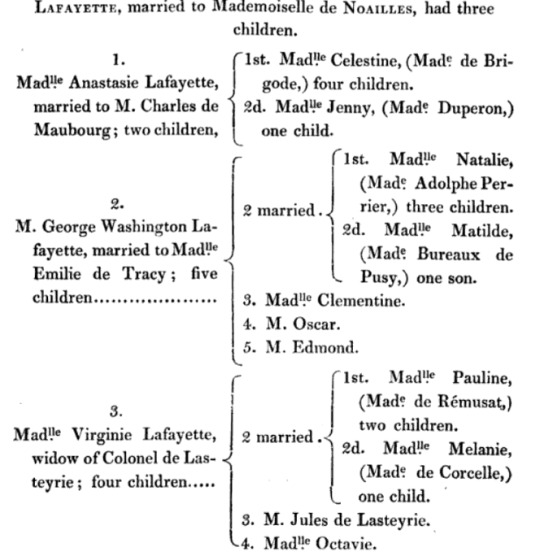
Jules Germain Cloquet, Recollections of the Private Life of General Lafayette, Baldwin and Cradock, London, 1835, p. 227.
All fine and dandy, but I was looking for more detailed information and I wanted to include the children that had already died by the time Cloquet publishes his book – I therefor made a graphic of my own. :-)
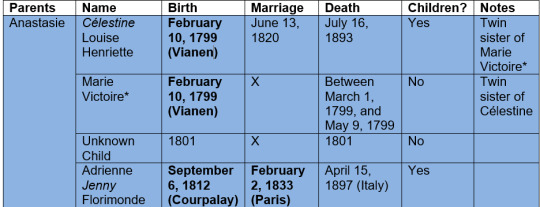
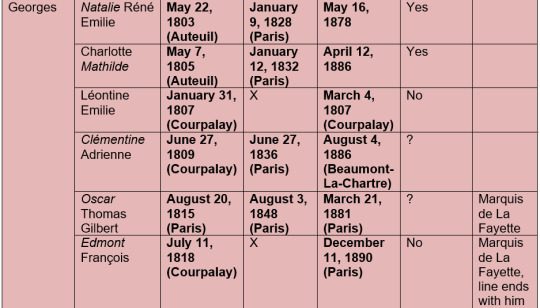
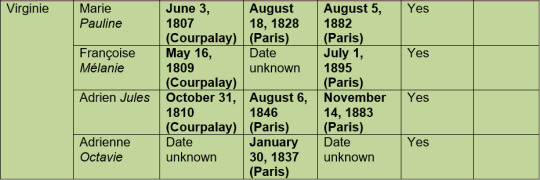
I am tempted to make one for the great-grandchildren as well, since La Fayette was very exited to become a Great-Grandfather – but this one was already a wild ride and La Fayette had more great-grandchildren then grand-children, let me tell you.
Anyway, some names are written in italics, these are the names the individuals commonly went by. I find it funny to see that all of Virginie’s children went by their second name, just like Virginie herself mostly just used her second name. Anastasie’s second child has an Asterix to her name. I have only once seen the name spelled out, on the certificate of baptism. The twins were baptized in Vianen (modern day Netherlands) and the name on the document was the Germanic spelling “Maria Victorina” – I used what I assumed is the best French spelling of the name.
The dates in bold indicate that the corresponding documentation of the birth/marriage/death can be found in the archives.
Anastasie and Charles: Finding Célestine’s dead twin sister was actually a surprise for me since I have never before seen her being mentioned. Anastasie gave birth for the first time in a town near Utrecht in what today are the Netherlands. The achieves there still have the certificate of baptism (on February 30, was the clerk sloppy or did the region in 1799 adhere to a different calendar style where February could have more then 29 days?) and we can very clearly see that there were too children. By May 9, 1799, La Fayette wrote to George Washington and referred to only one grand-child:
My wife, my daughters, and Son in law, join in presenting their affectionate respects to Mrs Washington & to you my dear g[ener]al the former is recovered & sets out for france on monday next with Virginia—our little grand Daughter [Célestine] is well, will your charming one accept our tender regard?
“To George Washington from Lafayette, 9 May 1799,” Founders Online, National Archives, https://founders.archives.gov/documents/Washington/06-04-02-0041. [Original source: The Papers of George Washington, Retirement Series, vol. 4, 20 April 1799 – 13 December 1799, ed. W. W. Abbot. Charlottesville: University Press of Virginia, 1999, pp. 54–59.] (02/12/2024)
I suspect that Anastasie had a stillbirth around August/September of 1801. La Fayette mentioned in a letter to Thomas Jefferson on June 21, 1801:
Anastasia Will Before long Make me Once More a Grand Father
“To Thomas Jefferson from Lafayette, 21 June 1801,” Founders Online, National Archives, https://founders.archives.gov/documents/Jefferson/01-34-02-0318. [Original source: The Papers of Thomas Jefferson, vol. 34, 1 May–31 July 1801, ed. Barbara B. Oberg. Princeton: Princeton University Press, 2007, pp. 403–404.] (02/12/2024)
There is no mention of this child being born and both the achieves in Paris and Courpalay yield no information so that it is unlikely that the child was born and then died young. Georges’ daughter died very young and she still is in the archives. Given La Fayette’s wording we can assume that Anastasie’s pregnancy was already somewhat advanced and the term miscarriage is only used up until the 20th week of a pregnancy, after that it is considered a stillbirth.
Georges and Emilie: The couple lost at least one daughter, Léontine Emilie, young, aged just four weeks. La Fayette wrote in a letter to Thomas Jefferson on February 20, 1807:
My family are pretty well and beg to be most affectionately respectfully and gratefully presented to you—We expected a Boy to be called after your name—But little Tommy has again proved to be a Girl [Léontine Emilie].
“To Thomas Jefferson from Marie-Joseph-Paul-Yves-Roch-Gilbert du Motier, marquis de Lafayette, 20 February 1807,” Founders Online, National Archives, https://founders.archives.gov/documents/Jefferson/99-01-02-5122. [This is an Early Access document from The Papers of Thomas Jefferson. It is not an authoritative final version.] (02/12/2024)
La Fayette later wrote to James Madison on June 10, 1807:
We Have Had the Misfortune to Loose a female Child of His, four Weeks old [Léontine Emilie]. My Younger daughter Virginia Has Lately presented us With an other infant of the Same Sex [Marie Pauline]. My Wife’s Health is Not Worse at this Moment, But Ever too Bad.
To James Madison from Marie-Adrienne-Françoise de Noailles, marquise de Lafayette, 10 June 1807,” Founders Online, National Archives, https://founders.archives.gov/documents/Madison/99-01-02-1768. [This is an Early Access document from The Papers of James Madison. It is not an authoritative final version.] (02/12/2024)
As a sidenote because it confused me while searching for the letter; the archives list Adrienne as the author. I am certain that is wrong because a) Adrienne was not corresponding with James Madison, b) this is not her writing style but La Fayette’s, c) the letter does not have her typical signature and d) there is the passage about the authors wife’s health – this one at the least gives it away.
Identifying Léontine Emilie was actually quite a bit of luck as well. I found the letter to Madison by accident and that letter is the only source that mentions her that I know of. I have never seen her in any other letters, documentation, contemporary or secondary books. The letter helped to narrow her birthday and her date of death down and with that information I searches the archives in Paris and Courpalay in the hopes of finding the child – and I was lucky. While I of course understand the order of things, it still saddens me to see that you can be born into such a prominent family – your father was a Marquis, your grand-father was the Marquis, and still, not even your families biographers care to even mention you.
Virginie und Louis: For all I know, and I again have to say that I have not nearly as much data/correspondence as I would like with regard to these topics, Virginie never lost a child. There is always the question what La Fayette would feel comfortable telling and to whom. There is also the question if La Fayette himself was always aware of everything. For example, in the case of a miscarriage very early on in the pregnancy he might have not included it in his correspondence or in fact maybe not even known himself.
As much as would wish a happy family life for Virginie, stillbirths, infant deaths and especially miscarriages were and still are not uncommon.
I have put excerpts from a few more letters by La Fayette to his American friends under the cut that help identify his grandchildren.
La Fayette to Thomas Jefferson, June 4, 1803:
I am Here, with my Wife, Son, daughter in law, and New Born little grand daughter [Natalie Renée Émilie] taking Care of my Wounds, and Stretching My Rusted Articulations untill I can Return to my Beloved Rural Abode at La Grange.
“To Thomas Jefferson from Lafayette, 4 June 1803,” Founders Online, National Archives, https://founders.archives.gov/documents/Jefferson/01-40-02-0361. [Original source: The Papers of Thomas Jefferson, vol. 40, 4 March–10 July 1803, ed. Barbara B. Oberg. Princeton: Princeton University Press, 2013, pp. 485–486.] (02/12/2024)
La Fayette to Thomas Jefferson, April 20, 1805:
Here I am with my son and daughter in law who is going to increase our family [Charlotte Mathilde]. Her father is to stand god father to the child and if He is a Boy we intend taking the liberty to give Him Your Name.
“To Thomas Jefferson from Marie-Joseph-Paul-Yves-Roch-Gilbert du Motier, marquis de Lafayette, 20 April 1805,” Founders Online, National Archives, https://founders.archives.gov/documents/Jefferson/99-01-02-1556. [This is an Early Access document from The Papers of Thomas Jefferson. It is not an authoritative final version.] (02/12/2024)
La Fayette to Thomas Jefferson, April 8, 1809:
(…) My Children are in Good Health. Two of them, My daughter in Law [Clémentine Adrienne], and Virginia [Françoise Mélanie] are Going to increase the family.
“To Thomas Jefferson from Marie-Joseph-Paul-Yves-Roch-Gilbert du Motier, marquis de Lafayette, 14 December 1822,” Founders Online, National Archives, https://founders.archives.gov/documents/Jefferson/98-01-02-3215. [This is an Early Access document from The Papers of Thomas Jefferson: Retirement Series. It is not an authoritative final version.] (02/12/2024)
#marquis de lafayette#la fayette#french history#history#letters#founders online#george washington#thomas jefferson#james madison#archieve#resources#1799#1801#1812#1803#1805#1807#1809#1815#1818#1810#georges de la fayette#anastasie de la fayette#virginie de la fayette
49 notes
·
View notes
Note
Like learning about Dinosaurs, you say?
Here's a list:
Aardonyx
Aardonyx (Afrikaans aard, "earth" + Greek onux, "nail, claw") is a genus of basal sauropodomorph dinosaur. It is known from the type species Aardonyx celestae found from the Early Jurassic Elliot Formation of South Africa. A. celestae was named after Celeste Yates, who prepared much of the first known fossil material of the species. It has arm features that are intermediate between basal sauropodomorphs and more derived sauropods.[1]
Based on the structure of the hind limbs and pelvic girdle of Aardonyx, the dinosaur normally moved bipedally but could drop to quadrupedal movement similar to Iguanodon. It shares some attributes with giant quadrupedal sauropods like Apatosaurus.[2] Australian[3][4] paleontologist Adam Yates and his team's discovery of the genus was published online before print in Proceedings of the Royal Society B in November 2009, and was scheduled to appear in the March 2010 issue.[2] British paleontologist Paul Barrett of the Natural History Museum, London, who was not involved in the research, commented that the discovery of Aardonyx "helps to fill a marked gap in our knowledge of sauropod evolution, showing how a primarily two-legged animal could start to acquire the specific features necessary for a life spent on all-fours".[2]
According to Matthew Bonnan, a co-author of the study, "We already knew that the earliest sauropods and near-sauropods would be bipeds. What Aardonyx shows us, however, is that walking quadrupedally and bearing weight on the inside of the foot is a trend that started very early in these dinosaurs, much earlier than previously hypothesized." Bonnan adds, "On a scientific level, it's really fulfilling to have a hypothesis on how you think dinosaurs got large, then to test that in the field and get back these kind of data — a new dinosaur — that really does start to fill in some of those anatomical gaps." ------
Giraffatitan [Synonym of Abdallahsaurus]
Giraffatitan (name meaning "titanic giraffe") is a genus of sauropod dinosaur that lived during the late Jurassic Period (Kimmeridgian–Tithonian stages) in what is now Lindi Region, Tanzania. Only one species is known, G. brancai, named in honor of German paleontologist Wilhelm von Branca, who was a driving force behind the expedition that discovered it in the Tendaguru Formation. Giraffatitan brancai was originally described by German paleontologist Werner Janensch as a species of the North American sauropod Brachiosaurus from the Morrison Formation, as Brachiosaurus brancai. Recent research shows that the differences between the type species of Brachiosaurus and the Tendaguru material are so large that the African material should be placed in a separate genus.
Giraffatitan was for many decades known as the largest dinosaur but recent discoveries of several larger dinosaurs prove otherwise; giant titanosaurians appear to have surpassed Giraffatitan in terms of sheer mass. Also, the sauropod dinosaur Sauroposeidon is estimated to be taller and possibly heavier than Giraffatitan. Most size estimates for Giraffatitan are based on the specimen HMN SII, a subadult individual, but there is evidence supporting that these animals could grow larger; specimen HMN XV2, represented by a fibula 13% larger than the corresponding material on HMN SII, would have measured around 23–26 metres (75–85 ft) long and weighed about 40–48 metric tons (44–53 short tons). ------
Adamantisaurus
Adamantisaurus (/ˌædəˌmæntɪˈsɔːrəs/ AD-ə-MAN-tiss-OR-əs) is a poorly-known genus of titanosaurian sauropod dinosaur from the Late Cretaceous Period of what is now South America. It is only known from six tail vertebrae but, as a sauropod, it can be assumed that this dinosaur was a very large animal with a long neck and tail.Sculpture of Adamantisaurus
Like many titanosaurians, Adamantisaurus is incompletely known, making its exact relationships difficult to establish. However, similarities have been noted with Aeolosaurus and the Bauru Group titanosaurian formerly known as the "Peiropolis titanosaur", now called Trigonosaurus. ------
Agustinia
Agustinia (/ɑːɡəˈstɪniə/) is a genus of sauropod dinosaur from the Early Cretaceous of South America. The genus contains a single species, A. ligabuei, known from a single specimen that was recovered from the Lohan Cura Formation of Neuquén Province in Argentina. It lived about 116–108 million years ago, in the Aptian–Albian stages of the Early Cretaceous Period.
-Dinosaur over-sharer.
these are very cool :) /srs
(i wish i had more to say sorry!!)
7 notes
·
View notes
Text
"Herzl replied—and quickly, in a letter on March 19. His letter was probably the first response by a leader of the Zionist movement to a cogent Palestinian objection to its embryonic plans for Palestine. Herzl simply ignored the letter’s basic thesis, that Palestine was already inhabited by a population that would not agree to be supplanted. Although Herzl had visited Palestine once, in an 1898 visit timed to coincide with that of German Kaiser Wilhelm II, he (like most early European Zionists) had not much knowledge of or contact with its native inhabitants. Glossing over the fact that Zionism was ultimately meant to lead to Jewish control of Palestine, Herzl deployed a justification that has been a touchstone for colonialists and that would become a staple argument of the Zionist movement: Jewish immigration would benefit Palestine’s Indigenous inhabitants. “It is their well-being, their individual wealth, which we will increase by bringing in our own,” Herzl wrote, adding that “no one can doubt that the well-being of the entire country would be the happy result.” Herzl’s letter addressed a consideration that Yusuf Diya had not even raised: “You see another difficulty, Excellency, in the existence of the non-Jewish population in Palestine. But who would think of sending them away?” But Herzl had underestimated his correspondent. From Yusuf Diya’s letter, it is clear that he understood perfectly well that at issue was not the immigration of (as Herzl put it) “a number of Jews” into Palestine, but rather the transformation of the entire land into a Jewish state. Instead, Herzl offered the preposterous inducement that the colonization, and ultimately the usurpation, of their land by strangers would benefit the people of that country. Herzl’s reply to Yusuf Diya appears to have been based on the assumption that the Arabs could ultimately be bribed or fooled into ignoring what the Zionist movement actually intended for Palestine. This condescending attitude toward the intelligence, not to speak of the rights, of the Arab population of Palestine was to be serially repeated by Zionist, British, European, and American leaders in the decades that followed, down to the present day. As for the Jewish state that was ultimately created by the movement that Herzl founded, as Yusuf Diya foresaw, there was to be room for only one people, the Jewish people. As for the others, “sending them away” was indeed what happened, despite Herzl’s disingenuous remark." - Rashid Khalidi, The Hundred Years' War on Palestine: A History of Settler Colonialism and Resistance, 1917���2017
79 notes
·
View notes
Text
Letter from Napoleon to his brother, Jérôme. A really interesting letter as I think it clearly displays his unique idealism:
My concern is for the well-being of your people [Westphalians], not only as it affects your standing and my own, but also because of the impact it has on the whole condition of Europe. Do not listen to anyone who says that your subjects, being so long accustomed to servitude, will fail to feel gratitude for the freedoms you bring to them. The common people of Westphalia are more enlightened than such individuals would have you believe, and your rule will never have a secure basis without the people’s complete trust and affection. What the people of Germany impatiently desire is that men without nobility but of genuine ability will have an equal claim upon your favor and advancement, and that every trace of serfdom and feudal privilege... be completely done away with. Let the blessings of the Code Napoleon, open procedures and use of juries be the centerpiece of your administration... I want all your peoples to enjoy liberty, equality, and prosperity alike and to such a degree as no German people has yet known.... Everywhere in Europe—in Germany, France, Italy, Spain—people are longing for equality and liberal government... So govern according to your new constitution. Even if reason and the enlightened ideas of our age did not suffice to justify this call, it still would be a smart policy for anyone in your position—for you will find that the genuine support of the people is a source of strength to you that none of the absolutist monarchs neighboring you will ever have.
Source: Napoleon to Jérôme, November 15, 1807, in Napoleon, Correspondance générale, ed. Thierry Lentz (Paris: Fayard, 2004), VII: 1321.
English translation: Alexander Mikaberidze, The Napoleonic Wars: A Global History
#Napoleon’s correspondence#Napoleon#napoleon bonaparte#The Napoleonic Wars: A Global History#napoleonic era#napoleonic#first french empire#Jerome#jerome bonaparte#Jérôme Bonaparte#Napoleon’s brothers#Napoleon’s reforms#napoleonic reforms#reforms#Westphalia#Germany#1807#1800s#Thierry Lentz#french empire#19th century#letter#letters
24 notes
·
View notes
Text


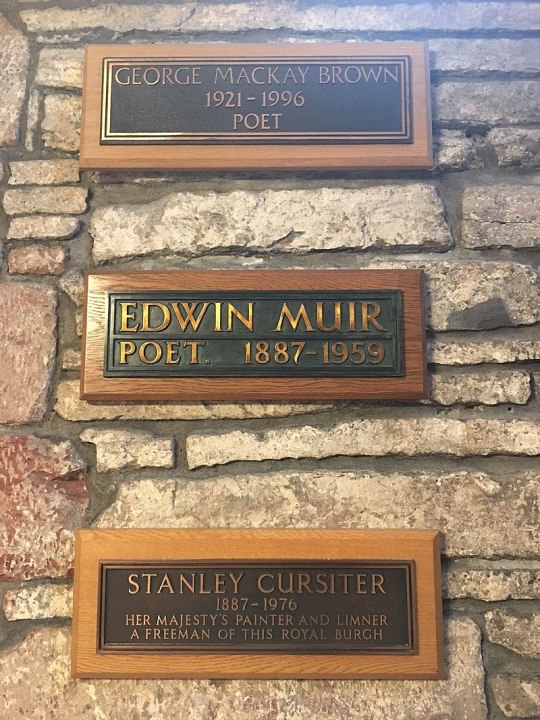
January 3rd 1959 saw the death of the poet and scholar Edwin Muir.
He was was born on a farm in Deerness , Orkney Islands in the remote northeast of Scotland. In 1901, when he was 14, his father lost the farm and the family moved to Glasgow. In Glasgow first his father, then his two brothers, and then his mother died in the space of a few years. His life as a young man in Glasgow was a depressing experience for him, involving a succession of unpleasant jobs. In 1919 he married Willa Anderson (they would later collaborate on English translations of such writers as Franz Kafka and Hermann Broch) and moved to London. From 1921 - 1923 he was in Prague, Dresden, Italy, Salzburg and Vienna; he returned to England in 1924. Between 1925 and 1956 Muir published seven volumes of poetry which were collected after his death and published in 1991 as The Complete Poems of Edwin Muir. From 1927 to 1932 he published three novels and in 1935 he came to St. Andrews where he produced his controversial Scott and Scotland (published in 1936). From 1946-1949 he was Director of the British Council in Prague and Rome. 1950 saw his appointment as Warden of Newbattle Abbey College (college for working class men) near Edinburgh and in 1955 he was made Norton Professor of English at Harvard University. He returned to England in 1956 but died in 1959 at Swaffam Priory , Cambridge and was buried near Cambridge.
His childhood in remote and unspoiled Orkney represented an idyllic "Eden" to Muir, while his family's move to the city corresponded in his mind to a deeply disturbing encounter with the "fallen" world. The emotional tensions of that dichotomy shaped much of his work and deeply influenced his life. His psychological distress led him to undergo Jungian analysis in London. A vision in which he witnessed the Creation strengthened the Edenic myth in his mind, leading him to see his life as an individual and his career as a poet as a working-out of archetypal fable. In his Autobiography he wrote, "the life of every man is an endlessly repeated performance of the life of man"; our deeds on earth constitute "a myth which we act almost without knowing it." Alienation, paradox, the existential dyads of good and evil, life and death, love and hate, and images of journeys, labyrinths, time and places fill his work.
His Scott and Scotland advanced the claim that Scotland can only create a national literature by writing in English; an opinion which placed him in direct opposition to the Lallans movement of Hugh MacDiarmid. He had little sympathy for Scottish nationalism. Remembered for his deeply felt and vivid poetry in plain, unostentatious language with few stylistic preoccupations, Muir is a relatively little known but significant modern poet. In 1965 a volume of his selected poetry was edited and introduced by T. S. Eliot. An excellent essay discussing Muir's literary career (Edwin Muir?s Journey, by Robert Richman ) is available in the online archives of The New Criterion. Many of Edwin and Willa Muir's translations of German novels are still in print.
Edwin Muir died in Cambridge on this day in 1959 and is buried in the churchyard of St Mary, Swaffham Prior, the village in which he spent his final years in Priory Cottage, directly opposite the churchyard. Muir is also remembered in St Magnus Cathedral, Kirkwall, Orkney
Friend, I have lost the way. The way leads on. Is there another way? The way is one. I must retrace the track. It’s lost and gone. Back, I must travel back! None goes there, none. Then I’ll make here my place, (The road leads on), Stand still and set my face, (The road leaps on), Stay here, for ever stay. None stays here, none. I cannot find the way. The way leads on. Oh places I have passed! That journey’s done. And what will come at last? The road leads on.
Edwin Muir
6 notes
·
View notes
Text

Hubris by Johannes Krause and Thomas Trappe
Why did we succeed when other hominins didn’t, and can lessons from our evolutionary past help rein in our destructive impulses?
In an institute in Germany, scientists are growing “Neanderthalised” human brain cells in a dish. These cells form synapses and spark as they would have done in a living Neanderthal as she (they are female cells) foraged or breastfed or gazed out of a cave mouth at dusk. That is the spine-tingling opening gambit of a book co-authored by one of the directors of the institute, Johannes Krause, and the information that sets it apart from a host of popular science books that attempt to predict humanity’s future based on our evolutionary past.
A mere 90 genetic differences distinguish modern humans, Homo sapiens, from Neanderthals, Homo neanderthalensis. That’s paltry, given the roughly 20,000 genes that make up the human blueprint, and not all of them affect the brain. Yet those 90 differences could explain why Neanderthals died out, some 40,000 years ago, while we went on to dominate the planet. They could hold the key to how we, the apparently more adaptable human type, might adapt again before we destroy the ecosystems we depend on, and ourselves along with them.
That, at least, is the rationale behind the German experiment. In order to really understand the effects of the differences, the scientists would need to build whole organs, ideally whole Neanderthals, and then compare them to modern humans on a suite of measures. Since they agree with most of the rest of us that this would be morally objectionable, they make do with rudimentary brains, so-called brain organoids (the Guardian’s science correspondent describes them as “lentil-sized” and “incapable of thoughts or feelings”). Building these already poses a technical challenge, and it will be a few years before they have completed the task.
Most of the rest of the book is given over to an update on the history of human evolution, which is something of a moving target at the moment, thanks to the 20-year-old technology that made it possible to extract and read DNA from ancient bones. The story gets more complicated with almost every telling, but one message comes through loud and clear: most branches of the human family were evolutionary dead ends. The only one that survived to the present day, us, very nearly didn’t. Something gave sapiens an edge, but what was it? Culture? The ability to build large social networks? A utopian dream and a kamikaze approach to realising it? Or chance?
Whatever it was made us aggressively expansionist, and nowhere were our expansionist tendencies more impressive than in Austronesia. Starting in Taiwan about 5,000 years ago, our ancestors cast off from a succession of overcrowded islands with animals, seeds and children on board, but no guarantee that they would glimpse the next piece of land within thousands of miles of ocean. The time came when modern humans had occupied every last atoll, then every last scrap of the habitable planet. Now we’re looking hungrily to the moon and Mars.
The biological urge to perpetuate one’s genes is not distinctively human; we share it with every other organism. Curiosity isn’t an exclusively human trait either; apes strayed out of Africa long before us. Nor were we always rapacious. The authors repeat a long-held claim that Easter Island, Rapa Nui to its original inhabitants, was stripped bare by those inhabitants’ descendants, who thereby ensured their own demise. But new research has questioned that interpretation, finding that people lived sustainably there prior to the arrival of Europeans in the 19th century.
We did survive all the other hominins, though, and that needs explaining. Krause and Trappe’s argument accommodates the Rapa Nui rethink, because they claim that it was only in the 20th century that Homo sapiens became Homo hubris – when the exponential growth in human population, technological innovation, mean global temperatures and biodiversity loss transformed us into an existential threat to ourselves. That transformation happened so fast that it must have been the product of cultural rather than biological evolution, but the capacity to adapt through culture ultimately lies in the genes.
The authors say there is no evidence that Neanderthals made art, which if true might imply that they were less capable of abstract thinking than us. Not everybody would agree with that, but most would concede that Neanderthals differed from us linguistically and cognitively. The question is: can we leverage those differences to rein in our avaricious impulses before it’s too late? Can we mobilise culture to override biology?
In case anyone needs reminding, that means coordinating the behaviour of 8 billion already-born for the good of the still-to-be-born. We’ve failed dismally so far, but maybe we still have it in us. Or maybe the real hubris is to think that we are anything other than a dead end waiting to happen. The Neanderthals roamed the planet for nearly 400,000 years; we have been here for 300,000. When all is said and done, who will be judged the winner (and who will judge)?
Daily inspiration. Discover more photos at Just for Books…?
6 notes
·
View notes
Text
Walter Schellenberg in Archives and Publications
Categories of MIUarchiv, click the title to view posts. German edition memoir: download
Handwriting and Photos Handwritten letter in English Photos from various sources Handwritten CV
Personnel and Identity Papers Personnel files (with a few photos) Passports (authentic & forged) Reichssportabzeichen Certifications of NSDAP, quitting from the catholic church, marriage, hunting, etc.
Correspondence and Memorandum Of private and official nature.
Interrogation and Testimony sometimes in a tune of gossip interview... Kurt Lindow on Schellenberg's personality and his relationship with Heydrich & Himmler Christl Erdmann(secretary) Wener Best Hans-Hendrik Neumann etc.
In Prison Inventory of Schellenberg's luggage seized (including some papers belonged to Robert Schmied, photos and letters of an unknown woman named "Peter") Correspondence in prison, with Hanna Reitsch, Count Bernadotte, Irene's family, the two lawyers, etc.
Schellenberg’s Final Years of Life After his release from prison he reunited with Irene and the children in Iburg. His attempt to enter Switzerland via regular proceedings almost succeeded. According to his doctor Francis Lang, Coco Chanel has covered his expenses of 30000 francs. And a little investigation into his burial place.
Divorcing Kaethe Kortekamp Plaintiffs, correspondence, Kaethe's meeting with Heydrich, etc.
Irene Grosse-Schönepauk and her Family She lived in Iburg, Hannover with the children and her mother in the post-war years, in poor condition.
Schellenberg's Parents and Siblings Bernhard & Elisabeth Schellenberg's participation in espionage Ludwig Schellenberg's trouble Correspondence with old Guido Schellenberg
Dr. Schellenberg? The question remained.
As Others Recalled Wilhelm Wulff's memoir Klaus Harpprecht on Schellenberg's peculiar assertation of Heinrich Mueller's defect to Soviet Union. (In progress) Friedrich Paulus' Story
Conference Minutes Amt-VI and RSHA Amt Chef conferences
Schellenberg’s Adjutant & Assistants Adjutant Erhard Urbannek: Schellenberg's Adjutant in IV-E Secretaries Hans-Heinrich Gaulke: Had worked with Schellenberg since the Amt I years. Executed for violation of Paragraph 175. Last seen in RSHA files in June 1943. Werner Krueger: Sent to the front or Eisnatzgruppen after boasting himself as "adjutant". Last seen in RSHA files in May 1942. Maira Schienke: Gaulke's successor. Christl Erdmann: Schienke's assistant. Personal assistant (Persönlicher Referent) Wilhelm Schmitz Assistant for liaison and reception Franz Göring
RSHA Offices Details of RSHA office buildings and guesthouses.
Other RSHA-Related Personalities
Uncategorized
For content translated into Chinese, please visit our WordPress page. 中文书摘译文等请访问Wordpress页面: https://miuarchiv.wordpress.com/
9 notes
·
View notes